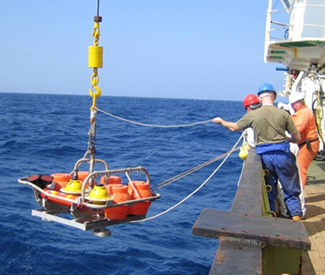ADCP landers

The early versions of these landers were built principally to deploy ADCPs (Acoustic Doppler Current Profilers). Because scientists were interested in current measurements near to the sea bed, these landers had a low profile so that the ADCP could be mounted as low as possible. This low-profile design has continued with the later versions.
The main principle of the design of all these types of lander is to have a system in two parts. The upper part, or instrument frame, is designed to carry the ADCP and other instruments, e.g. CTD (conductivity, temperature, depth), optical backscatter (turbidity = murkiness of the water and gives a measure of suspended sediment concentration), ADV (Acoustic Doppler Velocimeter – the same principle as an ADCP but measures very rapidly at a single point). The instrument frame is made buoyant enough so that, on its own, it will float on the sea surface. This is done by having air tanks (up to 50m depth capability), syntactic foam (up to 1000m) or glass spheres (very strong under pressure – can withstand depths of several kilometres) attached to the frame. The frame is then attached by a special release mechanism to a lower frame, usually called the bed frame, which is heavy enough to overcome the buoyancy of the instrument frame so that together they will sink to the sea bed.
The release system consists of a mechanical mechanism which holds the two parts of the lander together, one or more “burn wires” which hold the release closed and one or more acoustic transponders which can be signalled remotely to apply a voltage to the burn wires. When a voltage is applied to one of the wires in sea water it quickly burns through and the release is opened allowing the buoyant instrument frame to rise to the sea surface where it can be recovered.
In shallow water (up to about 200m) it is possible to retrieve the bed frame using a “spooler”. The spooler is a specially wound line contained in a canister attached to the instrument frame. The free end of the spooler line is attached to the bed frame and the other end is attached to the instrument frame. When the instrument frame is released and rises to the surface, the line unspools leaving the bed frame on the sea bed but still attached to the instrument frame. After the instrument frame is recovered and is secure on board ship, the line can be winched in to retrieve the bed frame. Although this is simple in principle, it is a tricky operation requiring careful coordination between the deck crew and the bridge. The ship needs to be carefully manoeuvred as the line is hauled in so that it never comes under too much tension. Any sudden movement of the ship, difficult to control in poor conditions, can easily result in the breaking of the line and the loss of the bed frame.